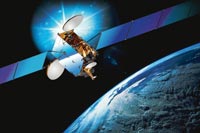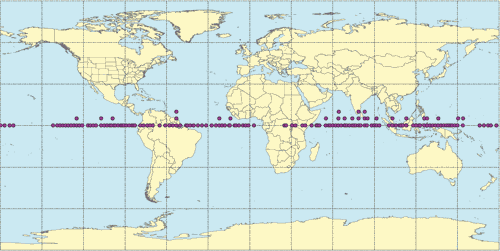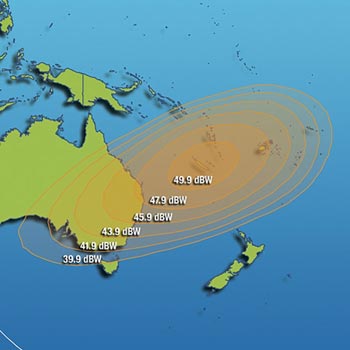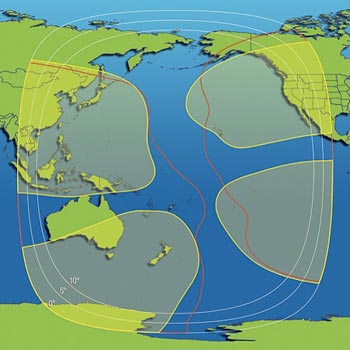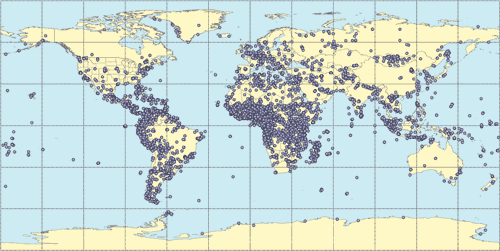
| Home : ITU News magazine | |||||||||||||||||||||||
JosÚ Albuquerque, Senior Director, Spectrum Engineering, IntelsatThe World Radiocommunication Conference (WRC-07) will address matters related to the identification of radio-frequency spectrum for IMT-2000 and systems beyond. (International Mobile Telecommunications-2000, or IMT-2000, is ITU’s global standard for third generation — 3G — wireless communications). In the opinion of many satellite operators, the frequency bands 3 400–4 200 MHz and 4 500–4 800 MHz (known as C-band) are not suitable for this purpose. The frequency ranges 3 400–4 200 MHz and 4 500–4 800 MHz are in the list of candidate bands that emerged from studies conducted within the ITU Radiocommunication Sector (ITU–R) in connection with this conference agenda item. Most existing C-band satellites use the first of these ranges for their downlink transmissions. The band 4 500–4 800 MHz is associated with the downlinks of the fixed-satellite service (FSS) Plan, and is intended to preserve orbit and spectrum resources for future use on an equitable basis by all countries.
Currently, there are some 160 satellites in the geostationary orbit using C-band frequencies for their downlink transmissions (see Figure 1). This is the equivalent of more than 3000 satellite transponders with a 36 MHz bandwidth with the potential for transmitting about 180 Gbit/s at any given instant. This infrastructure represents an investment in excess of USD 30 billion in spacecraft and launch costs alone, without taking into account investment in the ground segment made by users and satellite operators.
Deployment of IMT systems in these frequencies would drastically reduce the benefits that these resources have brought to users around the world, because fixed-satellite services and IMT systems cannot share frequencies in the same geographic area. Critical services delivered via C-bandC-band frequencies are used for downlink satellite transmissions that provide a wide range of services in developed and developing countries, including critical applications such as distance learning, telemedicine and universal access services; backhaul services (telephony, Internet); very small aperture terminal (VSAT) data links such as bank transactions or corporate networks; distribution of television programmes; mobile-satellite service feeder links, and emergency links, including disaster recovery services and meteorological tracking. These services require the high reliability and broad geographic coverage that can only be delivered in the C-band. C-band is effective for smaller marketsThe satellite beams in C-band cover large geographic areas and facilitate intercontinental and global communications. In higher frequencies, such as around 12 GHz (Ku-band) or 20 GHz (Ka-band), beams are more focused towards smaller areas to overcome the more severe signal attenuation due to atmospheric effects. This is illustrated by the downlink footprints of a satellite currently operating at 180║E, which are shown in Figure 2 for C-band and in Figure 3 for Ku-band. Due to their broad geographic reach, C-band beams allow for economically viable coverage of smaller markets and regions with low population density. In C-band, region-wide coverage can be provided with high availability, irrespective of rain zones, because rain fade effects are almost negligible in these frequencies. On the other hand, the severe rain fading effects on Ku-band or Ka-band signals require operators to create smaller beams focused on areas of high demand and population density, in order to maintain the required quality of service in an economically viable manner. IMT cannot share with FSS
It is not feasible to undertake co-frequency operation of FSS receiving Earth stations and transmitting fixed or mobile stations in IMT systems. ITU–R studies have concluded that separation distances of between tens of kilometres and a few hundred are required to ensure protection of FSS Earth stations. Considering that a typical city covers an area with radius of between 15 and 30 km, sharing between IMT systems and FSS receiving Earth stations is not realistic. In addition, IMT transmitters can also interfere with FSS Earth stations operating in adjacent bands. Unwanted emissions generated by IMT transmitters falling within the FSS desired signal cannot be filtered and will therefore generate interference. Furthermore, signals generated by an IMT transmitter can be strong enough to saturate the low-noise amplifier (LNA) of the FSS receiver. In view of the significant difference between the levels of the desired signal (originating at the satellite transmitter about 36 000 km away) and the interfering signal (originating at the IMT transmitter only a few kilometres away), filtering the IMT signal to the required levels might become unfeasible. The adjacent-band interference effects described above highlight the fact that identification of a portion of C-band frequencies for IMT systems, while keeping another contiguous portion for FSS use, is not free of interference problems and does not constitute a desirable approach. Mitigation techniques have been proposed in this context. However, given the order of magnitude of the separation distances required to reduce interference to acceptable values and the location of Earth stations in high density areas, application of mitigation techniques is not a realistic option. In particular, spectrum management techniques are not feasible because the weak signal coming from the satellite cannot be monitored by the IMT transmitter, and development of a database with information on the signals received by FSS Earth stations is unrealistic. For much the same reasons, site shielding is not practical either. The number of Earth stations involved is too large and such a solution, even if it could be implemented, would become too expensive. Number of Earth stationsIt is very difficult to make an accurate estimate of the number of C-band Earth stations around the world. Only a small fraction of those operating are individually notified to ITU. At the national level, data are also incomplete, especially because, in the vast majority of cases, receive-only (RO) Earth stations are not required to be registered (and actually are not registered) with the telecommunication authorities of each country.
As an example of this situation, in August 2006, approximately 6500 Earth stations deployed in the United States were in the database of its Federal Communications Commission (FCC), while it was known that there were more than 11 000 RO Earth stations operating in that country as cable head-ends. Another illustration is seen in Figure 4, which presents a map of Earth station locations of a single satellite operator. As explained, even for this single operator the map represents a substantial undercount of the actual deployment. C-band is not suitable for IMT systemsIt should be noted that C-band frequencies are not the most appropriate for IMT systems. In areas where population density is high, cell diameters will be based on usage requirements. In areas where population density is low, however, cell diameters depend on how far signals can reach. The characteristics of C-band will significantly increase costs as compared to deployment in lower frequency bands, because C-band signals, in addition to not being able to penetrate buildings, lose energy over distance much more than lower frequency bands. This would mean that IMT deployment to rural areas using C-band would be much more expensive. Furthermore, alternative bands are available for IMT. The World Administrative Radio Conference (WARC) in 1992 and the World Radiocommunication Conference in 2000 identified a band of around 750 MHz for IMT systems. Several other IMT candidate bands will be considered by WRC-07, mostly below 3 GHz. Given all the above circumstances, satellite operators are of the view that the frequency bands 3 400–4 200 MHz and 4 500–4 800 MHz (C-band) should not be identified for use by IMT systems, either globally or regionally.
|
|||||||||||||||||||||||
 Satellite operators challenge mobiles’ use of C-band
Satellite operators challenge mobiles’ use of C-band
